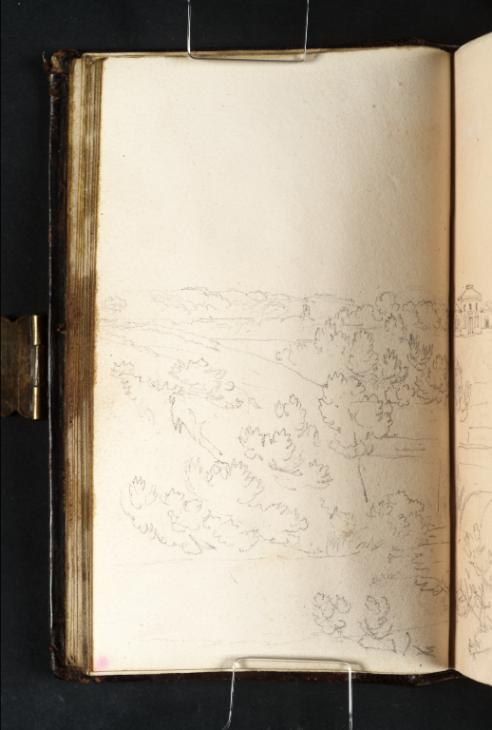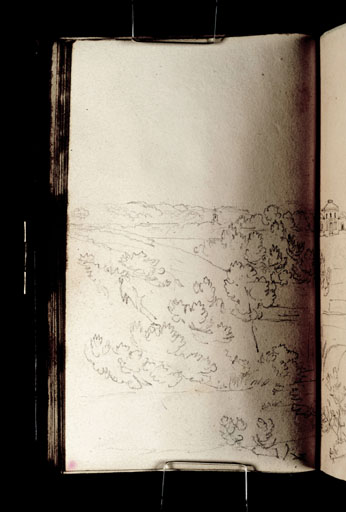Joseph Mallord William Turner Lime Grove, near Bangor 1799
Image 1 of 2
Joseph Mallord William Turner,
Lime Grove, near Bangor
1799
Joseph Mallord William Turner 1775–1851
Folio 17 Verso:
Lime Grove, near Bangor 1799
D02019
Turner Bequest XLVI 17a
Turner Bequest XLVI 17a
Pencil on white wove paper, 130 x 79 mm
Accepted by the nation as part of the Turner Bequest 1856
References
1909
A.J. Finberg, A Complete Inventory of the Drawings of the Turner Bequest, London 1909, vol.I, p.115 XLVI 17a (as ‘House on hill with bridge in foreground’ c.1799).
1984
Andrew Wilton, Turner in Wales, exhibition catalogue, Mostyn Art Gallery, Llandudno 1984, p.62 under no.74.
The drawing is continued on folio 18 recto opposite (D02020). A finished watercolour of Lime Grove, from much closer and from the south-east rather than, as-here, the south-west, is in the Fogg Museum, Cambridge, Massachusetts,1 but no drawing for it is known. It was formerly known as ‘Mansion in Wooded Grounds’, and was given its present identification by Susan Morris,2 who points out that Lime Grove was the home of Lord Penrhyn’s agent Benjamin Wyatt (1744–1818), the brother of Samuel Wyatt (1737–1807), architect of the house. The watercolour is a pair with one of the Penrhyn Arms, Port Penrhyn (Ashmolean Museum, Oxford),3 also designed by Samuel Wyatt. Turner was closely involved at this time with James Wyatt (1746–1813), whose Wiltshire work at Salisbury and Fonthill he was in the process of recording (see the Salisbury and Fonthill sketchbooks; Tate; Turner Bequest XLIX, XLVII), and as Morris suggests, it was probably the Wyatt family, not the Pennants, who were responsible for the commission of both watercolours.
Morris mentions that an engraving of the Lime Grove view by James Basire is credited to Lewis Wyatt (1777–1853). Stylistically Turner is clearly the artist of both drawings, but it is conceivable that Wyatt drew the initial outlines of the buildings. They were intended as plates in Lewis William Wyatt’s A Collection of Architectural Designs ... Executed in a Variety of Buildings, upon the Estates of the Right Hon. Lord Penrhyn (1800–1). This is characteristic of Turner’s relationship with the Wyatt family at the time: a proposed design for Fonthill was exhibited at the Royal Academy in 1798 as by James Wyatt (Yale Center for British Art, New Haven),4 although Turner seems certainly to have added the watercolour landscape to a drawing of the building by Wyatt’s office. It would seem that he undertook these two ‘house portraits’ as a notional member of the Wyatt office rather than as an independent artist. Given his already considerable celebrity, the relationship raises a number of questions: did James Wyatt employ Turner on the Fonthill project (and perhaps on the Salisbury project for Colt Hoare and the Brocklesby Mausoleum views) on condition that he might avail himself of the artist’s services for more menial jobs in his office?5
Andrew Wilton
May 2013
Andrew Wilton, J.M.W. Turner: His Life and Work, Fribourg 1979, p.337 no.328, reproduced, as ‘A mansion in wooded grounds’, c.1798.
Susan Morris, ‘“Two Perspective Views”, Turner and Lewis William Wyatt’, Turner Studies, vol.2, no.2, Winter 1983, p.34.
How to cite
Andrew Wilton, ‘Lime Grove, near Bangor 1799 by Joseph Mallord William Turner’, catalogue entry, May 2013, in David Blayney Brown (ed.), J.M.W. Turner: Sketchbooks, Drawings and Watercolours, Tate Research Publication, April 2016, https://www


